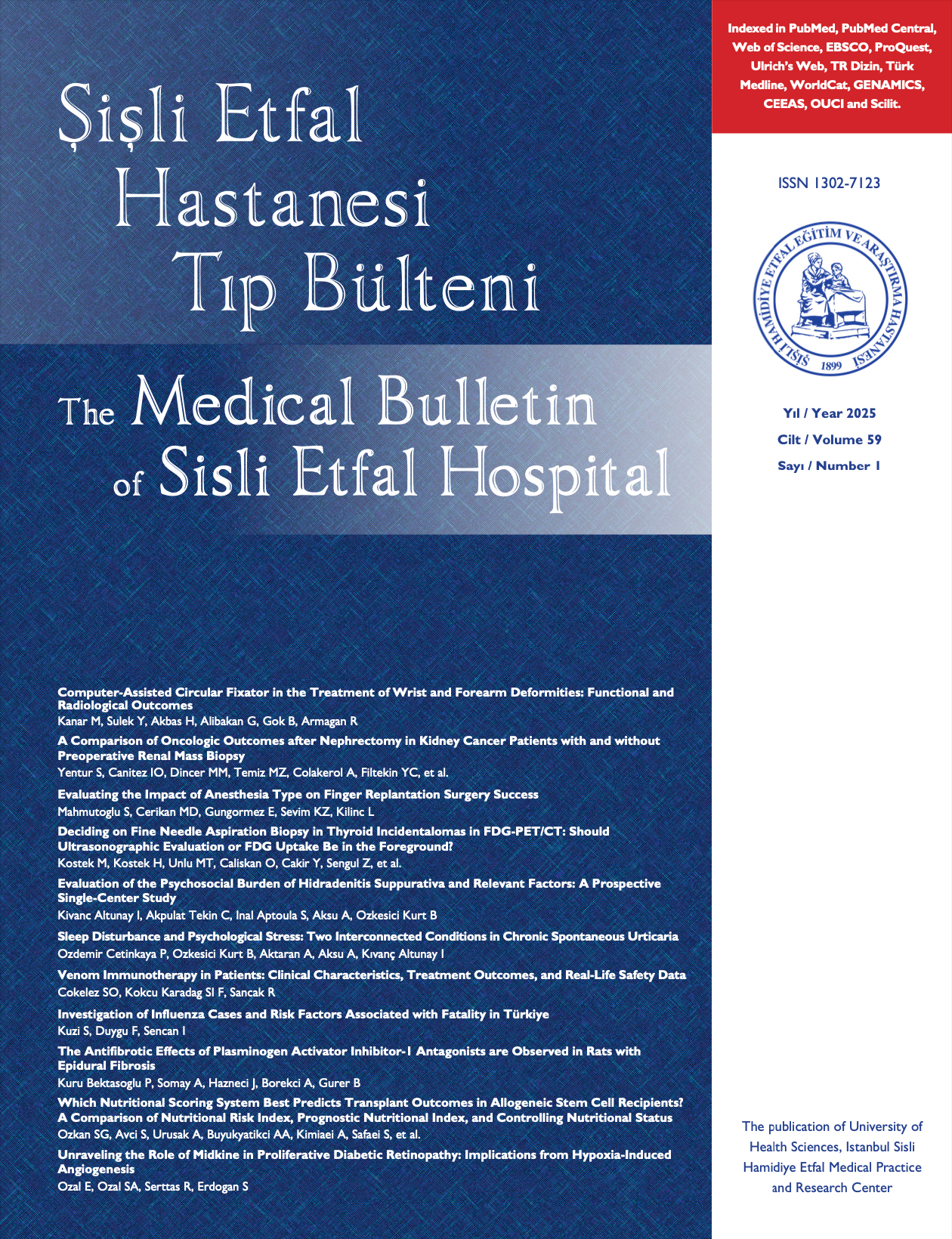
Hasta Özellikleri ve İnflamatuar Belirteçlerin Skorlama Sistemine göre Akut Pankreatitte Prognoz ile İlişkisi: Gerçek Yaşam Verileri
Cagatay Ak1, Resul Kahraman2, Suleyman Sayar2, Ebru Tarikci Kilic3, Gupse Adali2, Kamil Ozdil21Niğde Eğitim ve Araştırma Hastanesi, Gastroenteroloji Kliniği, Niğde2Sağlık Bilimleri Üniversitesi Ümraniye Eğitim ve Araştırma Hastanesi, Gastroenteroloji Kliniği, İstanbul
3Sağlık Bilimleri Üniversitesi Ümraniye Eğitim ve Araştırma Hastanesi, Anesteziyoloji Ana Bilim Dalı, İstanbul
Giriş/Amaç: Akut pankreatit (AP), morbidite ve mortalite oranı yüksek inflamatuar bir hastalıktır. Gastrointestinal sistem hastalıkları arasında en sık hastaneye yatış nedenlerinden biridir. AP'nin şiddetini öngören klinik faktörler ve inflamatuar markerlar hasta yönetimi için çok önemlidir. Bu çalışma, AP'nin şiddeti ile ilişkili faktörleri analiz edecektir.
Metot/Dizayn: Çalışma AP tanılı 514 hastadan oluşmaktadır. Hastaların demografik özellikleri, eşlik eden hastalıkları, AP etiyolojisi, vücut kitle indeksi (VKİ), sigara kullanımı, başvuru sırasındaki kan; amilaz, lipaz, lökosit, nötrofil, lenfosit, C-reaktif protein (CRP), ortalama trombosit hacmi (MPV), eritrosit dağılım genişliği (RDW), albumin, kalsiyum ve 48. saatteki CRP değerleri kaydedildi. Akut Pankreatitte Hasta Başı Şiddet İndeksi (BISAP), Ranson skoru, nötrofil-lenfosit oranı (NLR) ve trombosit-lenfosit oranı (PLR) değerleri hesaplandı ve kaydedildi. Bu parametreler ile Atlanta sınıflamasına göre AP şiddeti arasındaki ilişki analiz edildi.
Bulgular: Hastaların yaş ortalaması 55±17.8 idi. Hastaların yarısından fazlası kadındı (n: 272, %52,9). Biliyer nedenler en sık etiyolojik nedenlerdi (n: 299, %58,2). Hastaların çoğunda hafif pankreatit vardı (n: 416, %80.9). AP şiddeti tütün kullanımı, yüksek BMI, trombositoz, yüksek NLR, yüksek PLR, yüksek 48. saat CRP, hipoalbüminemi, hipokalsemi, aspartat aminotransferaz/alanin aminotransferaz oranı (AST/ALT oranı), yüksek Ranson ve BISAP skorları ile ilişkili olduğu bulundu.
Sonuç: Erken dönemde hızlı sonuç veren biyokimyasal belirteçler AP'nin şiddeti hakkında bilgi verebilir. Bu parametreleri birleştirerek yeni skorlama sistemleri geliştirilebilir. (SETB-2022-07-167)
Prediction of Prognosis Acute Pancreatitis with Inflammatory Markers and Patient Characteristics Compared to the Scoring System: Real-Life Data
Cagatay Ak1, Resul Kahraman2, Suleyman Sayar2, Ebru Tarikci Kilic3, Gupse Adali2, Kamil Ozdil21Department of Gastroenterology, Nigde Training and Research Hospital, Nigde, Türkiye2Department of Gastroenterology, Health Sciences University, Umraniye Training and Research Hospital, Istanbul, Türkiye
3Department of Anestesiology, Health Sciences University, Umraniye Training and Research Hospital, Istanbul, Türkiye
Objectives: Acute pancreatitis (AP) is an inflammatory disease with a high morbidity and mortality rate. It is one of the most common causes of hospitalization among gastrointestinal system diseases. Inflammatory and other factors that predict the severity of AP are very important for patient management. This study will analyze the factors associated with the severity of AP.
Methods: The sample consisted of 514 patients. Demographic characteristics, comorbid diseases, causes of AP, body mass index (BMI), tobacco use, blood at admission, amylase, lipase, leukocyte, neutrophil, lymphocyte, C-reactive protein (CRP), mean platelet volume, red cell distribution width, albumin, calcium, and CRP values at 48th h were recorded. The bedside index of severity in AP (BISAP), Ranson score, neutrophil-lymphocyte ratio (NLR), and platelet-to-lymphocyte ratio (PLR) values was calculated and recorded. The relationship between these parameters and the severity of AP was analyzed according to the Atlanta classification.
Results: Participants had a mean age of 55±17.8 years. More than half the participants were women (n=272, 52.9%). Biliary causes were the most common etiological causes (n=299, 58.2%). Most participants had mild pancreatitis (n=416, 80.9%). The severity of AP was associated with tobacco use, high BMI, thrombocytosis, high NLR, high PLR, high 48th h CRP, hypoalbuminemia, hypocalcemia, aspartate aminotransferase/alanine aminotransferase ratio (AST/ALT ratio), and high Ranson and BISAP scores.
Conclusion: Biochemical markers that give rapid results in the early period can provide information about the severity of AP. We may develop new scores by combining these parameters.
Makale Dili: İngilizce



















